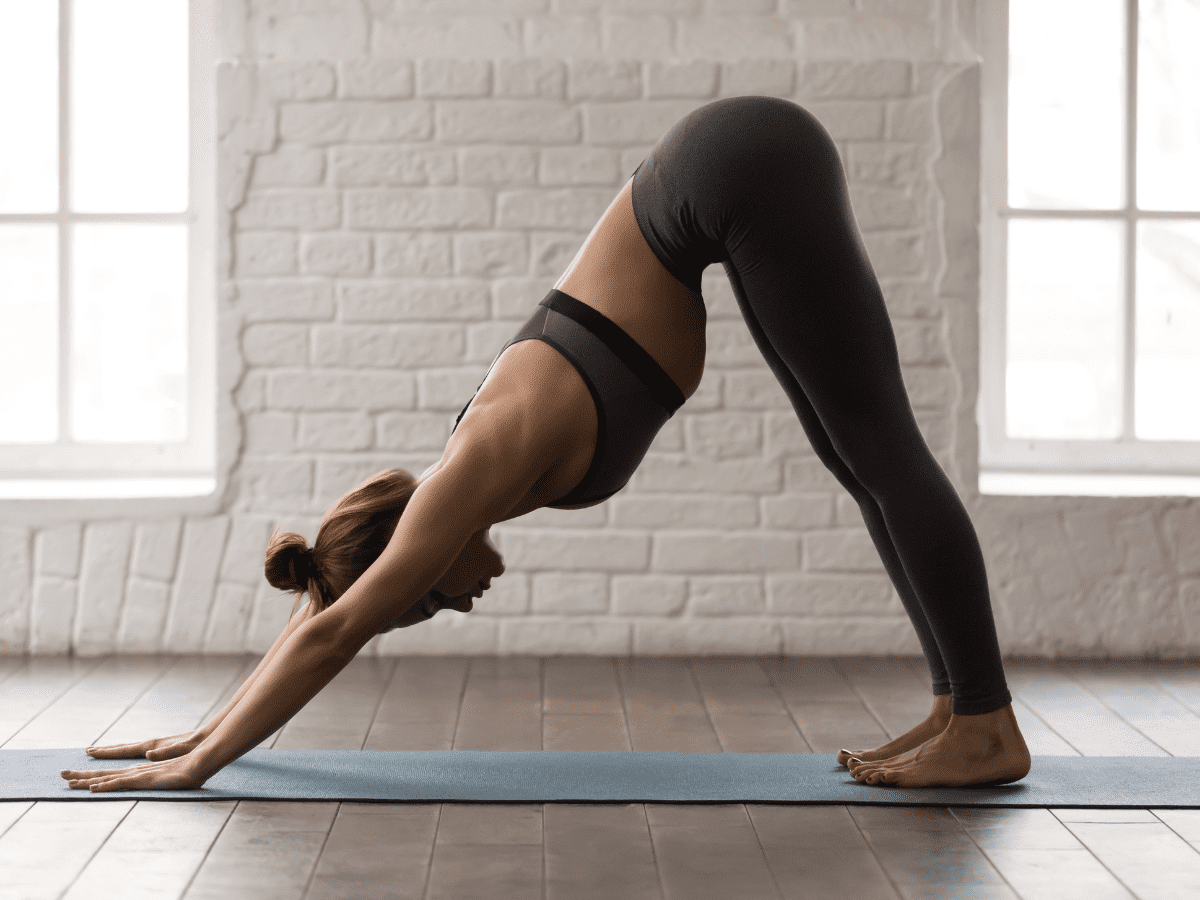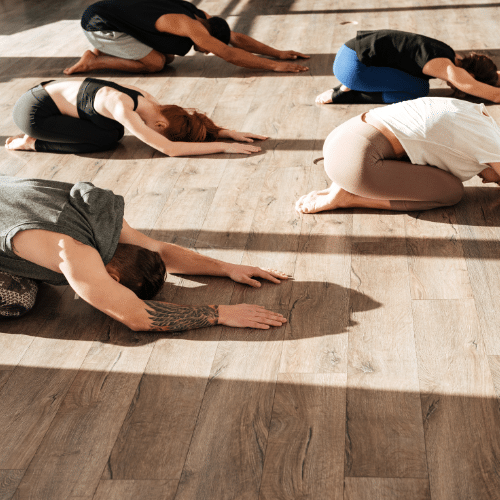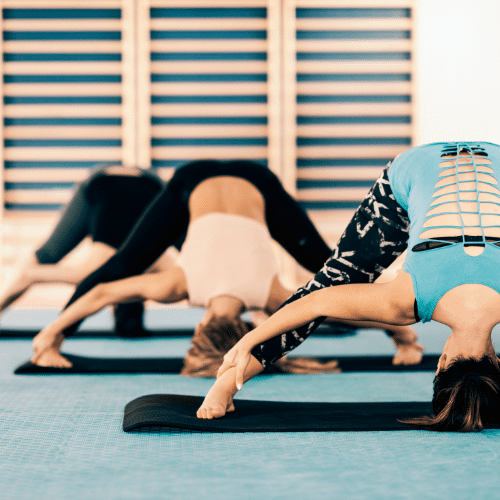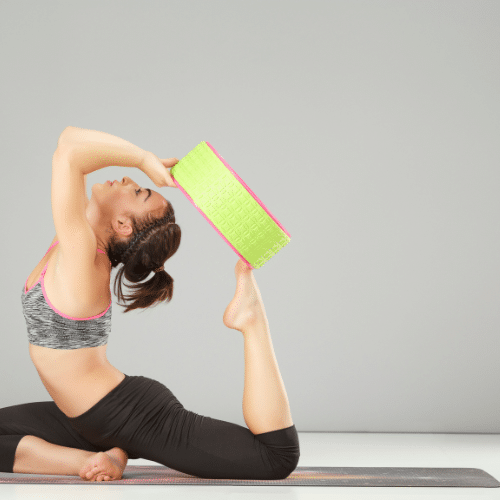Are you curious about the different kinds of Yoga? Let’s talk about one of the most popular types: Ashtanga Yoga. We will discuss what Ashtanga Yoga is and dive into the Ashtanga primary series, secondary series, and advanced.
Ashtanga has been recognized as one of the most well-liked yoga practices in the West since the late 1990s. The core of Ashtanga is a strong physical practice consisting of a sequence of postures connected with breath. Many people consider it a strenuous and challenging exercise since it requires a high degree of physical strength, flexibility, and endurance. No matter where you are in your yoga journey, adding an Ashtanga yoga class to your regular fitness routine is a great way to strengthen your body and mind. In this Ashtanga Beginner’s Guide, we will cover everything you need to know about this yoga practice before you add it to your repertoire.
Table of Contents
What is Ashtanga Yoga?
What Are the Series of Ashtanga Yoga?
What Are the 8 Limbs of Ashtanga Yoga?
Ashtanga’s Primary Series: Yamas
The Benefits of Ashtanga Yoga
What is Ashtanga Yoga?
Ashtanga is a vigorous and physically demanding style of Hatha Yoga that consists of six sets, or levels, of postures performed in a specific sequence. A strong emphasis on vitality and breath is at the heart of this practice, which originates in vinyasa, or the flow of movement between postures. Even though it’s a physically demanding activity, Yoga has been shown to improve concentration and calm the mind.
The Sanskrit roots of the term Ashtanga are “Ashta” and “Anga.” The words “Ashta” and “Anga” both mean “eight” and “limb,” respectively. So, Ashtanga Yoga is the coming together of all eight limbs of Yoga into a unified practice. The Ashtanga Yoga School’s philosophical underpinnings may be traced back to the yoga sutras, broken into these eight limbs. The Ashtanga Yoga school aims to unite all eight of its limbs into a unified practice. We’ll cover the eight limbs a little further down. First, let’s take a look at the six main series of Ashtanga Yoga.
What Are the Series of Ashtanga Yoga?
Usually, students begin their Ashtanga practice with five rounds of Sun Salutation A and Sun Salutation B. After this, you will do five repetitions of standing positions, followed by five repetitions of sitting poses. When you’ve gotten the hang of those two pose series, your yoga teacher will introduce you to the Advanced A, B, C, and D series.
Primary
Sun Salutation A, or Surya Namaskar A, is the primary Ashtanga Yoga series. Beginning and ending with Tadasana (Mountain Pose), this series of poses is a set of instructions on how to go through various positions.
The postures include a variety of stretches, forward folds, and backbends that are performed in a rhythmic cadence that is in sync with the breath to generate internal heat. Transitioning from one posture to the next begins at the beginning of an inhale. There is a pause in breathing and movement as you settle into the pose, and the onset of an exhale signals the following change in position. There is a tempo to the breathing, the moving, and the being motionless.
Like the orbit of its namesake star, the course of the sequence follows a predictable arc. It is cyclical, making it simple to lose oneself in the monotony of repeated actions. It’s like meditating while moving.
Secondary
Compared to Sun Salutation A, Sun Salutation B is more difficult on the muscles and the cardiovascular system, but it also features two additional positions. Sun Salutation A must be mastered well by yogis before Sun Salutation B is attempted.
Surya Namaskar B consists of six asanas that stimulate and balance the body’s internal systems, allowing for peak performance from every organ and gland. It is common to start a yoga lesson by getting the blood flowing and the muscles heated with Sun Salutation B. Utkatasana (Chair Pose) and Warrior I are added to make Sun Salutation B a total of 19 postures, as opposed to the 12 in Surya Namaskar A.
Since further Surya Namaskar B variants may be developed from Surya Namaskar B, it is considered a foundation position. Adding Surya Namaskar B to your flow yoga routine is a great way to increase your energy and feel more energized overall. It is common practice to do Surya Namaskar B as a prelude to more strenuous yoga postures or sequences.
The Advanced Series
The Advanced Series of Ashtanga Yoga is the third series sequence, also widely termed Advance A. The Advanced Series is known as Sthira Bhaga or Divine Stability and is broken into four parts: A, B, C, and D. Once a yogi has mastered the initial set of moves, they can move on to attempting the next, more strenuous and demanding, set of moves. Enhanced flexibility, strength, and attention are emphasized in addition to the original focus on energy flow. The series guides the yogi toward the ultimate purpose of self-realization.
The Advanced Series increases your Ashtanga yoga abilities by strengthening your breathing, postures, and gaze. To study and practice advanced postures regularly, your body must be in peak condition in terms of strength and flexibility.
The third series comprises arm-balancing poses that require the yogi to practice the postures with gravity to maintain bodily stability. The third series of Ashtanga yoga also has complex backbends. Backbends stretch the spine and activate energy pathways.
What Are the 8 Limbs of Ashtanga Yoga?
There are eight limbs of Ashtanga Yoga. They are as follows:
- Yama (ethical guidelines)
- Niyama (self-discipline)
- Asana (posture)
- Pranayama (breath control)
- Pratyahara (sensory withdrawal)
- Dharana (focus)
- Dhyana (meditation)
- Samadhi (enlightenment).
We will cover the primary limb, Yama, below.
Niyama, the second limb, often refers to inwardly focused obligations, but it may also be applied to our interactions with the world. In Sanskrit, the preposition ni indicates an action that takes place within.
Asana, the term used to describe the physical aspects of Yoga, really means “seat,” as in the seat you would occupy to engage in the meditative practice that is the third and last step on the journey to liberation. For this asana, “sthira sukham asanam” (stable and pleasant posture) is the sole alignment instruction offered.
Fourth, Prana is the Sanskrit term for energy or life force. Both our vitality and the energy of the cosmos at large may be summed up by one word. Also known as the breath, Prana is a powerful tool for altering one’s mind.
Fifth, Pratya means to “draw in,” “draw back,” or “withdraw,” and the second half, “ahara,” refers to whatever we “take in” on our own, such as the numerous sights, sounds, and fragrances our senses take in constantly. When we initially sit down to meditate, one of the first things we do is to concentrate on ‘drawing in’ or relaxing the body and mind.
To concentrate intently is to engage in Dharana. Dha means “holding” or “maintaining,” while Ana means “other” or “something else.” The intense concentration and focus are required to bring our senses inside and fully immerse ourselves in whatever we’re trying to focus on.
The seventh limb is Dhyana, “meditative absorption,” or the state attained when one is fully immersed in the object of their meditation. Meditation is not something we can actively ‘do,’ but rather, it describes the spontaneous action of something that happens as a result of everything else.
Samadhi, which has several meanings, including “bliss” and “enlightenment,” is the last destination of Patanjali’s Yoga Sutras. Our ultimate destination of joy awaits once we rearrange our connections with the world and ourselves.
Ashtanga Primary Series: Yamas
Yama, the first branch, refers to vows, disciplines, or practices that center on our relationship with the external world. Although Yoga has been shown to improve physical strength and flexibility and reduce mental stress, these benefits are of little use if we continue to live in a state of chronic rigidity, weakness, and anxiety.
The five Yamas are as follows:
- Ahimsa, or nonviolence
- Satya, or truthfulness
- Asteya, or nonstealing
- Brahmacharya, or proper use of energy
- Aparigraha, non-greed or non-hoarding.
The benefits of Yoga extend well beyond the mat; if we can learn to be compassionate, honest, and productive with our time and energy, we will help ourselves and the world around us.
The Benefits of Ashtanga Yoga
There are several positive outcomes associated with practicing Ashtanga yoga. Because of its notorious intensity, it is ideal for athletes and fitness enthusiasts. Like other forms of Hatha Yoga, Ashtanga yoga emphasizes breathing, physical postures, and meditative reflection.
Regular yoga practice may benefit your range of motion, lung capacity, and equilibrium. It helps you maintain a healthy weight, regulates your blood pressure and stress levels, and boosts your stamina, bone density, and muscular strength.
The advantages of Ashtanga yoga go well beyond the physical. It’s also beneficial on a mental and spiritual level since it helps one focus better in everyday life and have more clarity of thought.









